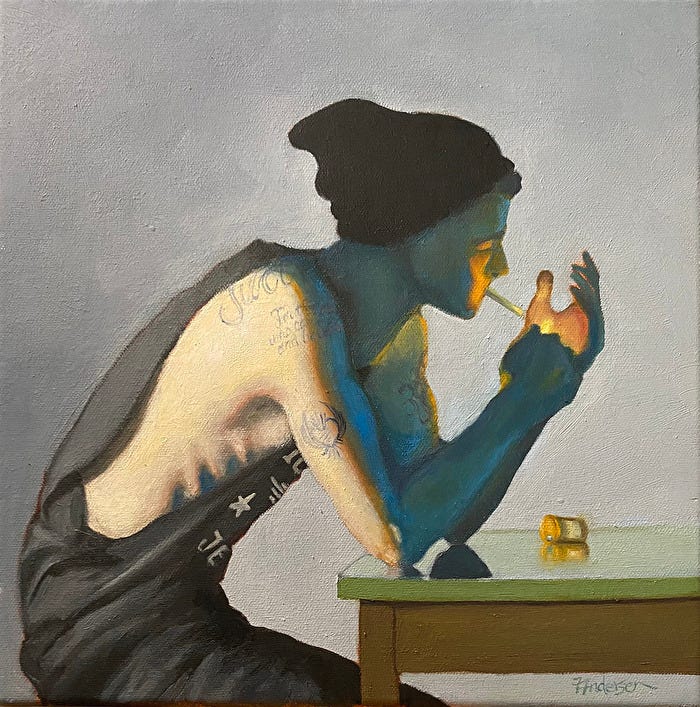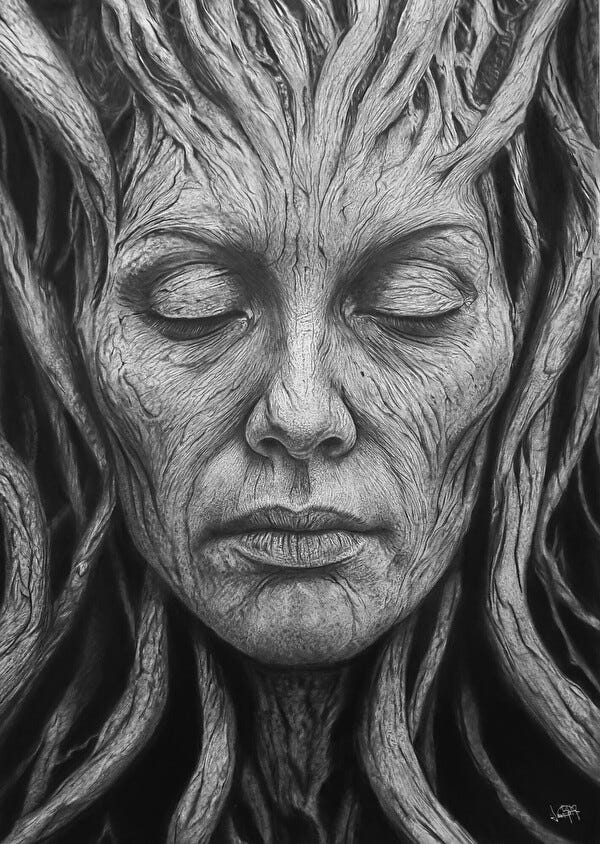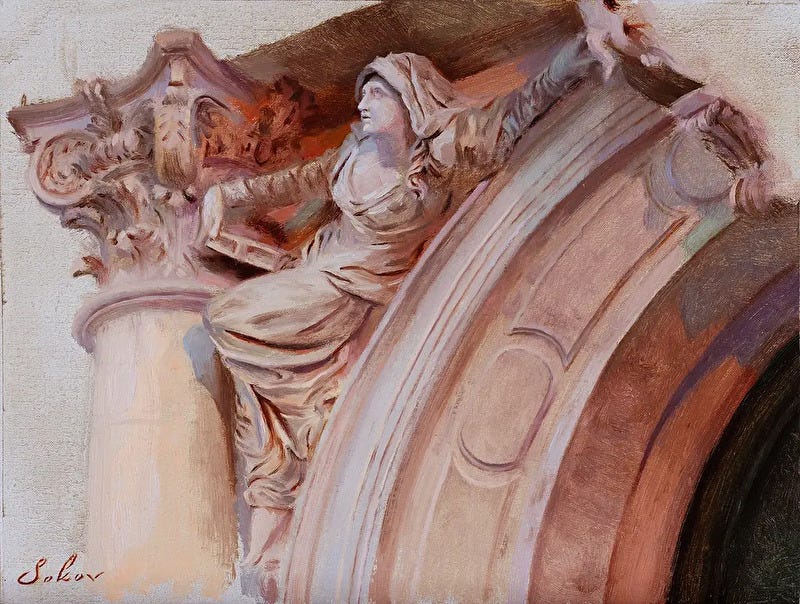Technology as Sorcery: Heidegger and Tolkien on the Saving Power of Sub-Creation
Escaping the Spell of the Machine
Note - this post may be truncated in providers like Gmail, for best reading experience click the button below
CALL FOR HELP
Help us Promote Human Artists and Push Back Against AI
Please support artists and help us get more exposure for the artists featured in this newsletter by clicking the “Like” icon ❤️, by clicking the “Restack” icon 🔁, or by leaving a comment. The more engagement we get, the more widely these images get shown. Help us support human artists and push back against the encroachment of AI!
Call for Art
We’re Looking for Art to Feature in these Newsletters

We do not use AI to generate images. We support human artists. And we’re always looking for great art by real artists to feature in our newsletters! If you are an artist (or know of one), please leave a comment with a link to your art. Each piece we feature goes to more than 100,000 inboxes and is properly attributed with backlinks to the artist’s website. We discovered some great art from artists who commented on our last article.
(See Clintavo’s Curated Corner after the article)
We have another post today by Eugene Terekhin, the man and the mind behind the publication Philosophy of Language.
Eugene is a regular contributing writer to The BoldBrush Letter.
This post originally appeared on Philosophy of Language here
Note - this piece will be locked after two days and be for paying subscribers only. Non-paid subscribers may continue to access it here.
Technology as Sorcery

“Everywhere we remain unfree and chained to technology, whether we passionately affirm or deny it. But we are delivered over to it in the worst possible way when we regard it as something neutral; for this conception of it, to which today we particularly pay homage, makes us utterly blind to the essence of technology.”
— Martin Heidegger, The Question Concerning Technology
What is the essence of technology according to Heidegger?
In its modern form, it is not a tool—it’s a way of revealing. But revealing what? A particular way of perceiving the world, which Heidegger calls enframing.
Enframing reduces everything to a “standing-reserve.” Modern technology is a lens through which everything in the world is reduced to a standing-reserve, something from which we can endlessly extract energy or resources.
Modern technology, therefore, is no longer neutral or merely instrumental. It imposes upon us a mindset that treats everything—even nature and human beings—as resources to be efficiently harnessed, optimized, and exploited for immediate ends.
J.R.R. Tolkien likens modern technology to black magic.
“The Machine is our more obvious modern form though more closely related to Magic than is usually recognised.”
— J.R.R. Tolkien, Letter 131
According to Tolkien, the lure of the Machine is that it arises from an apparently good root—a desire to benefit the world and others:
“…this frightful evil can and does arise from an apparently good root, the desire to benefit the world and others—speedily and according to the benefactor’s own plans.”
This is the very definition of black magic—using some external means to quickly impose my will upon the world. The motto of the Machine is “my will be done.” The lure of the Machine is that it allows me to quickly achieve my desire. The Machine is not about renouncing one’s will—it’s about establishing and enforcing it.
There’s only one counterpower that can pull the sting out of the Machine. Heidegger writes:
“Because the essence of technology is nothing technological… the decisive confrontation with it must happen in a realm that is, on the one hand, akin to the essence of technology and, on the other, fundamentally different from it. Such a realm is art.”
Modern technology teaches us to “establish our own will.” Because our hearts are not neutral either, we are easily tempted to use the Machine under the guise of “benefiting the world and others.” We seldom recognize this impulse as black magic, yet that’s precisely what it is. How do we resist this lure?
Through renouncing our will. Sub-creation stands in direct opposition to the Machine because the one engaged in sub-creation must renounce their will. Sub-creation occurs only when we are captivated by beauty of such magnitude that we forget ourselves entirely and respond to The Call. The moment our own will asserts itself, the experience of beauty is ruined.
A sub-creator is not concerned with imposing his will upon the world; he is totally captivated by the Call. He hears the Music from above and knows that the only way to reflect that Music on earth is to die to self and follow the Tune to the end. A true work of art is an embodiment of that heavenly Music.
“But where danger is, grows the saving power also.” — Heidegger
The saving power comes from the “magic of the Elves,” which Tolkien calls Art.

The saving power comes from the “magic of the Elves,”
which Tolkien calls Art.
Every Elvish blade, cloak, rope, boat, bow, arrow, bread, drink, phial, etc. has its distinct magic because it is infused with the Light of Lothlórien. When asked by Pippin about the magic of the elven cloaks, the leader of the Elves answered:
“They have the hue and beauty of all these things under the twilight of Lórien that we love; for we put the thought of all that we love into all that we make.”
The Elves infused everything they crafted with their love of Lórien. That’s why the works of their hands were truly magical—revealing the Music of Ilúvatar. The purpose of the Machine is the domination of beings; the meaning of Art is the revelation of Being.
The Machine empowers the will; Art teaches us to renounce our will because the will stands in the way of Beauty. A sub-creator’s art reveals Being and infuses it into the work of his hands. This is a different kind of magic—one that unites heaven and earth.
PS — Editor’s Note: Please support artists and help us get more exposure for the artists featured in this newsletter by clicking the “Like” icon ❤️, by clicking the “Restack” icon 🔁, or by leaving a comment. The more engagement we get, the more widely these images get shown. Help us support human artists and push back against the encroachment of AI!
FASO Loves Jan Stommes’ paintings

Wouldn’t You Love to work with a website hosting company that actually promotes their artists?
As you can see, at FASO, we actually do, and,
we are the only website host we know of that does.
Click the button below to start working
with an art website host that actually cares about art.
Clintavo’s Curated Corner



We’re Looking for Great Art!
If you know of a great piece of real visual art (no AI art) that we should consider for future illustration of our articles or to feature in Clintavo’s Curated Corner, please click the button below and leave a sentence or two explaining what you like about a piece with a link to it on the web. It may be your own art or someone else’s (please do not send via email as we are much less likely to see or respond to those, thank you):
PS - Wouldn’t You Love to work with a website hosting company that actually promotes their artists?
Click the button below to start working with an art website host that actually cares about art.
No AI Zone: Everything written in this post (and all our posts) is written 100% by flesh and blood humans
We do not use AI images with our writing. We prefer to feature and provide more exposure for human artists. If you know of a great piece of art we should consider, please leave a comment with a link to it. All featured images are properly attributed with backlinks to the artist’s website. You can help support human artists and push back against AI by liking or restacking this piece by clicking the “Like” icon ❤️, by clicking the “Restack” icon 🔁 (or by leaving a comment).



Thanks for supporting true art. I am a realist pastel artist and love working in that medium because of its vibrancy. My website is https://www.paulharman.com
Instagram@paulharman
My name is
Susana Maria Rosende,
I am a Writer, Whimsical Artist/Illustrator, and Photographer.
Links:
*https://www.artpal.com/Susana-Rosende
* https://www.instagram.com/Art.House.2017
* https://www.tiktok.com/@Art.House.2017